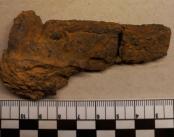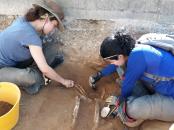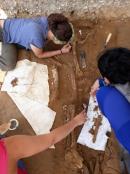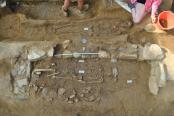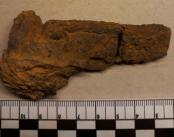CAMPAGNA 2019 |
1° SETTIMANA |
2° SETTIMANA |
3° SETTIMANA |
4° SETTIMANA |
5° SETTIMANA |
6° SETTIMANA |
7° SETTIMANA |
8° SETTIMANA |
9° SETTIMANA |
10° SETTIMANA |
31 LUGLIO 2019 
Resoconto della giornata di scavo
Area 6000
NORTH SECTOR
Along the western limit of the sector we proceeded with the removal of the individual USK 6524, oriented WE and deposed supine in US - 6556. it oriented WE, of which part of the lumbar region is preserved, the forearms, the pelvis and the lower limbs. The upper portion of the body continues beyond the section and the western boundary of the area. Further south-east has begun the investigation of a new sepulchral trench located immediately south of the USM 6123 lithic chest tomb; the US 6252 filler removal is highlighting the remains of an individual in a WE-oriented anatomical connection, which will be exposed in the coming days.
SOUTH SECTOR
Today the commissioning was completed and the removal of individuals USk 6273 and 6276 began. Both bear the signs of the imposing sepulchral activity in the area of the churchyard, as they lacked numerous anatomical portions. This is the result of the burial actions subsequent to the aforementioned burials, which involuntarily removed even large portions of the skeletons already present but, obviously, not identifiable from the ground level at the time of interception.
6000/s
We began to remove skeleton 6273 and we are nearly finished removing all of it. However, we still have some elements we need to remove, though we managed to get most of it, including the skull.Today points and photos were taken of skeleton 6276 for GIS and photogrammetry purposes. Skeletal and stratigraphic context sheets for the skeleton were filled out before the bones were then taken out of the ground. They will be edited incase certains bones and features were hidden or still covered at the time of the photos. The bones removed today include both feet, lower limbs, hands, and the skull. The cranium and mandible surprisingly came out of the ground all at once and we were able to wrap it in geotextile immediately.
Area 7000
Continua lo scavo della piccola fornace US 7047, dalla quale emergono nuovi frammenti di bronzo e carboni. L'esposizione di parte della sua superficie interna ha messo in evidenza la porzione settentrionale, che diversamente da come ipotizzato negli scorsi giorni continua formando un cerchio interrotto solo per 20 cm nella porzione meridionale di essa. Inoltre la pulizia effettuata sugli strati della porzione sud orientale dell'area ci ha permesso di rinvenire un artefatto molto interessante: si tratta del frammento di un'elsa di baselardo, un pugnale molto frequente tra i militari del basso medioevo. La sua caratteristica principale è quella di essere realizzato interamente partendo da un unico pezzo di ferro. Il frammento da noi ritrovato, di circa 10 cm di lunghezza mostra la lavorazione del metallo ribattuto su se stesso e compresso per raggiungere la forma desiderata. L'elsa inoltre presenta un scanalatura centrale tipica di molti di questi pugnali.








